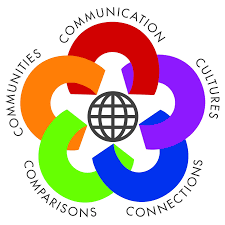
The current study of another language and culture gives students a powerful key to successful communication: knowing how, when, and why to say what to whom. The 21st-century learning of a world language may be a different experience than parents of our students experienced.
These words encompass all the linguistic and social knowledge required for effective communication. In the past, world language teaching concentrated on the how (grammar) to say what (vocabulary). While these components of language remain crucial, the current emphasis is on communication, or what students can do or communicate in meaningful contexts with the new or target language. This also highlights the when, the why, and the to whom (the sociolinguistic and cultural aspects of language) the new language will be used in every day life.
The study of another language and culture enhances ones personal education in many ways. When students learn a world language, they gain new respect for and understanding of their own language, as well as appreciation of other languages.
The study of another language and culture greatly increases ones ability to see connections across the curriculum. Since the content of a foreign/world language course includes history, geography, social studies, science, math, and the fine arts, it is easy for students to develop an interdisciplinary perspective while gaining intercultural understanding.
The study of any foreign/world language and culture provides an especially rich preparation for the future. It is difficult to imagine a job, profession, career, or leisure activity which would not be enhanced by the ability to communicate effectively with others. Furthermore, the skills and knowledge derived from foreign/world language study make it possible for students to be responsible citizens in the global community.
The Prince William County Foreign Language Curriculum focuses attention on the broader view and identifies five essential elements/strands of foreign/world language study:
- Communication;
- Cultures;
- Connections;
- Comparisons; and
- Communities
The five C's of foreign language education as defined in the National Foreign Language Standards.
The Five Elements of World Language
- Communication:
Communication is at the heart of second language study, whether the communication occurs through speaking, listening, reading, or writing. - Cultures:
Through the study of languages, students gain knowledge and understanding of the cultures that use that language. Students cannot truly master the language they study until they understand the cultural contexts in which the language exists. - Connections:
Students make connections across disciplines and access new sources of information through the study of another language. - Comparisons:
Through comparisons and contrasts with the new language, students develop greater insight into their own language and culture and discover multiple ways to view the world. - Communities:
Students become lifelong learners as they use the language both within and beyond the school setting.
None of these goals can be isolated; they all interconnect and comprise the richness of human language.
